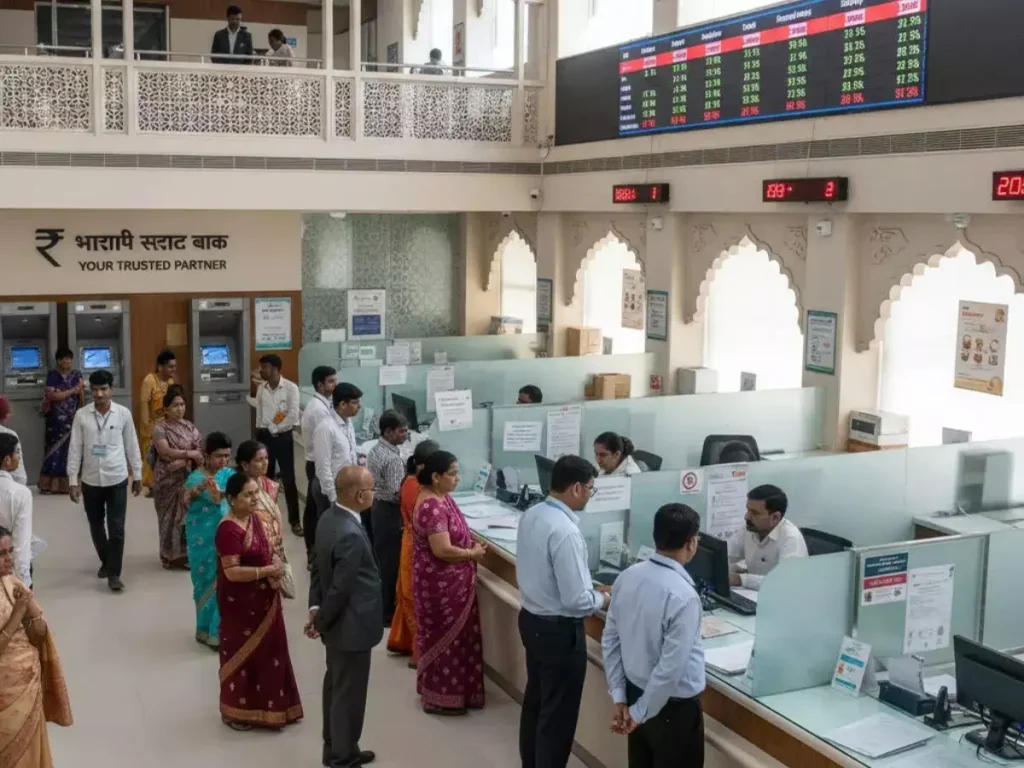About Indian Banks and Loan Losses: Indian banks are increasingly being recognized for their strong ability to weather financial stress, even amid global uncertainties, economic slowdowns, and sector-specific challenges. According to S&P Global Ratings, the country’s banking sector is poised to absorb potential loan losses due to robust corporate balance sheets, solid earnings, and prudent risk management practices. The resilience of Indian banks has become particularly evident as they navigate fluctuating global markets, tariffs, currency fluctuations, and evolving domestic regulations.
The banking sector’s ability to handle shocks is underpinned by strong pre-provision operating profits, diversified loan portfolios, and low exposure to high-risk sectors. S&P Global Ratings highlighted in its latest report, India Banks: Primed for Growth, that while earnings are expected to moderate, they will remain above long-term averages. The forecasted loan growth, supported by potential tax cuts and regulatory easing, ensures that Indian banks remain well-capitalized and capable of absorbing credit costs without compromising stability.
Despite challenges such as slower demand, cautious lending, and a shift in depositor behavior toward mutual funds, equities, and real estate, Indian banks continue to demonstrate resilience. Their reliance on secured retail lending, low exposure to tariff-hit sectors, and effective hedging of foreign borrowings contribute to a buffer against potential shocks, maintaining overall sectoral stability.
How Indian Banks Absorb Potential Loan Losses
Strong Corporate Balance Sheets and Earnings
Indian banks are benefiting from healthier corporate balance sheets. Many large corporates have deleveraged over the past few years, reducing reliance on high-risk debt. This, combined with consistent earnings, allows banks to absorb moderate loan losses without impacting profitability severely. S&P expects pre-provision operating profits of 3.6% to 3.7% of loans, which provides a strong cushion for absorbing credit costs.
Low Exposure to Vulnerable Sectors
A key factor in the resilience of Indian banks is their limited exposure to high-risk, tariff-sensitive sectors. Sectors like textiles and gems and jewellery constitute only about 2% of total loans, minimizing the impact of global trade disruptions. Additionally, banks’ foreign borrowings are just 5% of total funding, with around 75% of corporate external commercial borrowings (ECBs) hedged against currency risk.
Read about: Planning Your First Personal Loan in 2025? Here’s How to Borrow Smart
Asset Quality and Credit Costs Outlook
S&P projects a slight softening of asset quality, with weak loans expected to rise to 3.0%–3.5% and credit costs increasing to 80–90 basis points. While non-performing loans (NPLs) in corporate lending are expected to average 1.1% over the next two years, overall NPLs could rise to 1.7%–1.8% due to stress in SME and retail loans. Nevertheless, banks’ robust operating profits and conservative lending practices ensure they can manage these incremental risks effectively.
Credit Growth and Lending Trends
Despite a cautious approach to lending, credit growth is forecasted at 11.5%–12.5% for fiscal years 2026 and 2027. This growth is supported by potential tax cuts, regulatory easing, and continued demand for secured retail loans. Even though slower demand may temper lending activity, the overall outlook remains positive, reflecting banks’ strategic positioning to balance growth with asset quality.

Challenges in Deposit Growth
While banks show resilience in loan absorption, deposit growth may lag as savers increasingly allocate funds to mutual funds, equities, and real estate. This could push banks to rely more on wholesale and offshore funding, which may have cost implications. Despite this, the low exposure to vulnerable sectors and effective risk management practices mitigate the impact of slower deposit growth.
Conclusion
Indian banks’ strong balance sheets, solid earnings, and conservative risk management practices make them well-positioned to absorb loan losses even in the face of global uncertainty. Limited exposure to vulnerable sectors, effective hedging strategies, and robust pre-provision operating profits provide a cushion against rising credit costs.
The projected rise in non-performing loans is manageable, thanks to prudently structured corporate and retail lending. While credit growth may slow slightly, regulatory support, tax incentives, and continued demand for secured loans are expected to sustain overall growth.
Although deposit growth may face headwinds, Indian banks’ strategic reliance on wholesale and offshore funding ensures that liquidity needs are met without significant disruption. Their resilience allows them to navigate economic volatility while maintaining profitability above long-term averages.
Overall, Indian banks are demonstrating a strong capacity to absorb financial shocks, ensuring stability for the economy and confidence among investors, corporates, and retail customers alike.
Also read: सऊदी सरकार $10 बिलियन के दुर्लभ ऋण सौदे की तैयारी में
FAQs About Indian Banks and Loan Losses
1. Why are Indian banks able to absorb potential loan losses?
Indian banks are equipped to handle loan losses due to strong corporate balance sheets, solid earnings, and conservative lending practices. Limited exposure to high-risk sectors, effective hedging of foreign borrowings, and high pre-provision operating profits provide a buffer to absorb credit costs without severely impacting profitability.
2. What sectors are considered vulnerable for Indian banks?
Vulnerable sectors include textiles, gems and jewellery, and other trade-sensitive industries. However, exposure to these sectors is low, around 2% of total loans, which minimizes the impact of global trade disruptions and tariffs.
3. How will non-performing loans (NPLs) evolve in the next two years?
S&P forecasts that NPLs in corporate lending will average 1.1% per year, while overall NPLs may rise to 1.7%–1.8% due to stress in SME and retail loans. This indicates a slight softening in asset quality but remains manageable given banks’ strong operating profits.
4. What is the expected credit growth for Indian banks?
Credit growth is projected at 11.5%–12.5% for fiscal years 2026 and 2027. This growth is supported by potential tax cuts, regulatory easing, and continued demand for secured retail loans.
5. How might slower deposit growth affect banks?
As savers shift funds to mutual funds, equities, and real estate, deposit growth may lag. This could increase reliance on wholesale and offshore funding. However, banks’ strong capital base and liquidity management strategies help mitigate any negative effects.

2 thoughts on “Why Indian Banks Are Well-Positioned to Absorb Loan Losses”